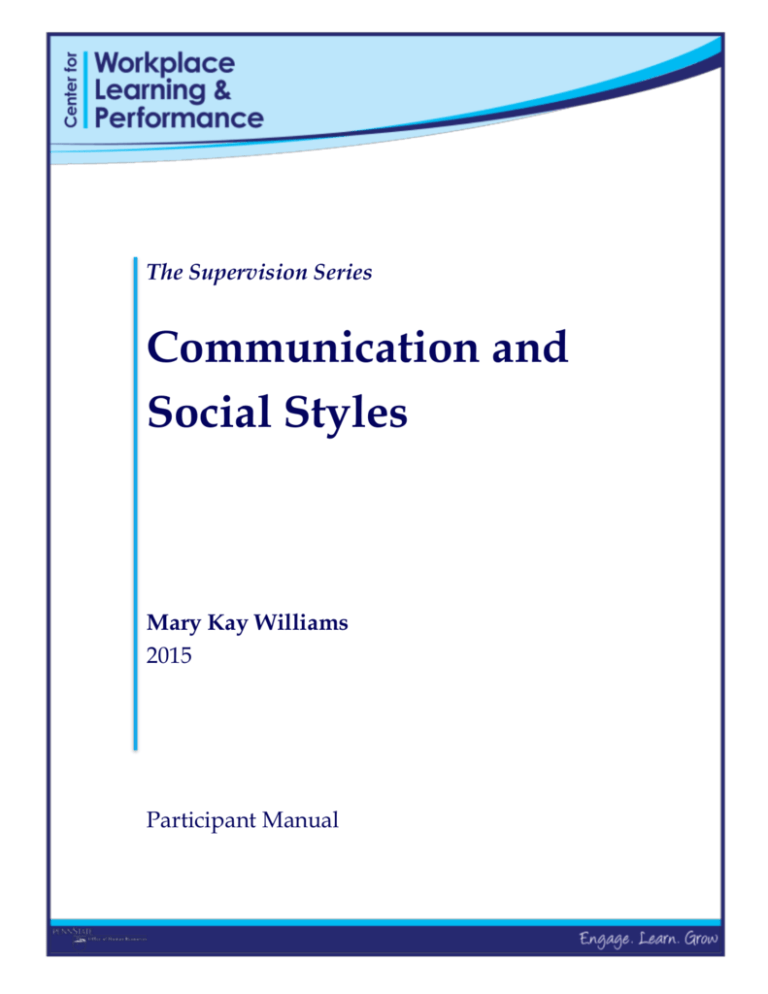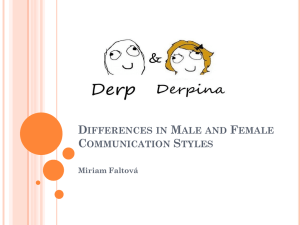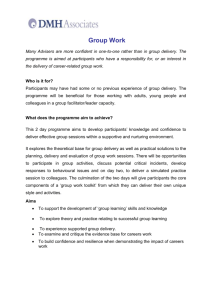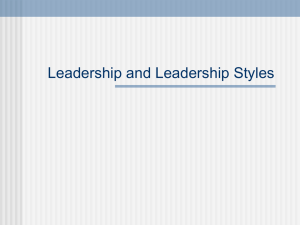
The Supervision Series
Communication and
Social Styles
Mary Kay Williams
2015
Participant Manual
© 2012 The Pennsylvania State University. All rights reserved.
Requests for permission to reuse these materials may be directed
to: The Center for Workplace Learning & Performance
at learning@psu.edu or 814-865-8216.
The Pennsylvania State University encourages qualified persons with disabilities to participate
in its programs and actions. If you anticipate needing any type of accommodation or have
questions about the physical access provided, please contact the Center for Workplace
Learning & Performance at 814-865-8216 (or learning@psu.edu) in advance of your
participation or visit. This publication is available in alternative media on request.
Communication and Social Styles
ii
Center for Workplace Learning & Performance
Table of Contents
Communication .......................................................................................... Page 2
Social Styles ................................................................................................. Page 10
Communication and Social Styles
iii
Center for Workplace Learning & Performance
Communication and Social Styles
Goal:
In this seminar, we’ll look at developing communication skills and determine our individual
social styles.
Learner Outcomes:
In this program you will:
Examine a communication model.
Identify barriers to effective communication.
Learn active listening techniques to successfully respond to others.
Recognize the importance of asking questions.
Discover ways that our perceptions affect communication.
Complete the social styles inventory to discover your social style and gain insight into
your behavioral strengths and weaknesses.
Communication and Social Styles
1
Center for Workplace Learning & Performance
Describe a recent conversation in which there was a miscommunication. This could be at
work, home, while shopping, etc.
What you heard…
____________________________________________________________________________________
____________________________________________________________________________________
____________________________________________________________________________________
____________________________________________________________________________________
____________________________________________________________________________________
____________________________________________________________________________________
____________________________________________________________________________________
____________________________________
What the other person meant…
____________________________________________________________________________________
____________________________________________________________________________________
____________________________________________________________________________________
____________________________________________________________________________________
____________________________________________________________________________________
____________________________________________________________________________________
____________________________________________________________________________________
____________________________________________________________________________________
______________________________
What went “wrong?”
____________________________________________________________________________________
____________________________________________________________________________________
____________________________________________________________________________________
____________________________________________________________________________________
____________________________________________________________________________________
____________________________________________________________________________________
____________________________________________________________________________________
____________________________________________________________________________________
______________________________
Communication and Social Styles
2
Center for Workplace Learning & Performance
Communication and Social Styles
3
Center for Workplace Learning & Performance
Communication
Why communication is important.
Communication is a necessary tool for understanding. Miscommunication may actually be a
cause of conflict, stress, or misunderstandings. The better we communicate the more effective
we are at creating and maintaining good relationships.
Communication is a social function. It is a two-way process (sending and receiving) by which
ideas are transmitted from one person to another. In doing so, we try to accomplish four basic
things: to be understood, to understand others, to be accepted, and to get something
accomplished.
Process of communication: Sending and Receiving Messages
Communication and Social Styles
4
Center for Workplace Learning & Performance
Factors influencing communication
Context – the situation in which the communication takes place. This has a great impact on
how we interpret verbal and non-verbal messages.
Interpretation – the receiver determines the intent of the message through the message
content. This is often where miscommunication occurs.
Feedback – the roles of sender/receiver reverse many times during any conversation.
Feedback is interpreted as a follow-on message which, in turn, creates more feedback.
Barriers – obstructions to effectively getting our message correctly interpreted.
Semantics – the meaning (or an interpretation of the meaning) of words.
Jargon – the vocabulary peculiar to a particular trade, profession, or group.
Acronym – a word formed from the initial letters or groups of letters of words in a phrase.
Communication and Social Styles
5
Center for Workplace Learning & Performance
Active Listening
Active listening is:
____________________________________________________________________________________
____________________________________________________________________________________
____________________________________________________________________________________
____________________________________________________________
Active listeners internalize the speaker’s feelings and try to see things from his or her
perspective. Active listeners appreciate both the meaning and the feelings behind what the
speaker is saying. By understanding the speaker’s attitudes and feelings, we can better
understand his or her point of view.
Verbal communication: The words we hear. The words we say.
____________________________________________________________________________________
____________________________________________________________________________________
____________________________________________________________________________________
____________________________________________________________
Non-verbal communication: What we see. What our body “says” to others.
____________________________________________________________________________________
____________________________________________________________________________________
____________________________________________________________________________________
____________________________________________________________
Para-language: How we say it.
____________________________________________________________________________________
____________________________________________________________________________________
____________________________________________________________________________________
____________________________________________________________
What percent of meaning comes from each?
Verbals
_____%
Nonverbals
_____%
Paralanguage _____%
Communication and Social Styles
6
Center for Workplace Learning & Performance
Perceptions: two or more people listening to the same conversation may interpret that
conversation differently. Everyone has a way of thinking that shapes what we see and hear.
Perceptions are formed by our values, experiences, culture, and expectations.
Perception and Communication
People must communicate to get work done. The better the understanding between coworkers, the more efficient, effective, and creative we can become.
Communication is a mutually influencing process. That is, we form beliefs and knowledge
about fellow workers based on our interactions and “history” with them. We know what the
person is like, what he or she will do in a given situation, and how the person views us. We
can predict, to a certain degree, others’ actions or reactions to life’s events.
Similarly, our “reality” affects what we see and hear and (therefore) how we respond to
situations. We reject “wrong” information rather than change our beliefs. As an example, if
you think someone is unable to handle a difficult assignment, you are likely to see his or her
inability to do so. This is the Pygmalion Effect.
Is Perception Reality?
Let’s say Al is Mark's supervisor. They are standing near the water cooler and, with loud
voices and strong gestures, they are talking to each other. If you don’t hear them, what might
you conclude? One may draw an inaccurate conclusion. Perhaps they both came from a
culture where loud speaking and constant gesturing is the norm. Be careful about jumping to
conclusions based solely on what you see or what you hear. These are incomplete messages.
We interpret words and behaviors and draw conclusions based on our perception.
Communication and Social Styles
7
Center for Workplace Learning & Performance
Asking Questions
Questions help us to gain information, insight, and understanding. It is valuable to ask openended questions because you gain more information than with closed-ended questions.
Which of the following questions are open-ended?
What concerns do you have?
What’s your view of the situation?
Could you describe what happened when…?
What concerns you about the situation?
Can you tell me what’s been happening?
What might work for you?
What would make this idea work better for you?
Are there things you can do to help resolve this issue?
What other suggestions do you have?
Can you help me understand why…?
What problems might there be with this idea?
Have we covered everything?
Are there any parts of this potential solution you’re not comfortable with?
Can you live with this every day from now on?
Communication and Social Styles
8
Center for Workplace Learning & Performance
Good and Poor Listening Behaviors
______________________________
______________________________
______________________________
______________________________
______________________________
______________________________
_____________________________
_____________________________
_____________________________
_____________________________
_____________________________
_____________________________
Sharpen your listening by trying these simple steps:
Communication is difficult and complicated. Therefore, speakers and listeners have
responsibilities to each other. The speaker’s responsibility is to organize his or her thoughts
and communicate them as effectively as possible.
The listener’s responsibility is to listen actively to understand. Listen For “what” and “why.”
That is, try to determine the meaning (what) of the message, as well as the purpose of the
communication (why).
Don’t interrupt the speaker. Interrupting or arguing with the speaker will guarantee the
message does not get across. Interruptions break the speaker’s train of thought and sidetrack
the message. We often tend to interrupt when we disagree with the other person and try to
refute or counter his or her logic.
Mirror back the thought. If we can express others’ ideas in our own words, we can verify we
have the intended meaning. If we haven’t interpreted the message as intended, the speaker
can repeat or clarify his or her meaning using different words.
Look for agreement. When we hear something that is unacceptable, we stop listening and
mentally counter what was said. If we listen for points of agreement, many arguments will
disappear.
Communication and Social Styles
9
Center for Workplace Learning & Performance
Mixed Messages
The speaker’s words say one thing, but the nonverbals may be interpreted as something
completely different. When we sense a mixed message, we tend to attach greater meaning to
the nonverbals than to the verbals. In cases like this, simply ask for clarification or reframe the
conversation for verification.
Nonverbal Feedback
As a listener, your nonverbals are just as powerful as when you are the speaker.
You could be sending mixed messages if you don’t pay attention, face the speaker, and make
good eye contact. It is also helpful to use supportive nonverbals, such as nodding or saying
“uh-huh.” These interjections show the other person that you are engaged in the conversation.
Communication and Social Styles
10
Center for Workplace Learning & Performance
Social Styles
The Social Styles instrument is designed to help people understand themselves and others
better, communicate more effectively, and to develop positive relationships with co-workers.
The Social Styles behavioral model allows us to see ourselves and others from a perspective of
differing dynamics. Understanding the four styles helps create more effective working
relationships.
The four styles are determined by looking at two dimensions…the amount of emotion one is
comfortable showing and the degree of assertiveness one usually exhibits.
Refer to your Social Style Self-Perception Profile booklet (page 7).
Communication and Social Styles
11
Center for Workplace Learning & Performance
The Driver Social Style
Drivers tend to be highly assertive and action oriented. They control their emotions and focus
on tasks and results rather than on people and processes. They trust facts and data more than
intuition and concentrate more time on getting the job done than on developing relationships.
They are quick to assess a situation and prefer getting into the action rather than analyzing in
depth and proceeding with caution. When they’ve identified a preferred result or course of
action, they are comfortable directing others to ensure the desired results are achieved.
Drivers are also comfortable proceeding on assumptions rather than on verified facts and they
respond quickly to complex, challenging situations.
Notes:
Communication and Social Styles
12
Center for Workplace Learning & Performance
The Expressive Social Style
Expressives are highly assertive and action oriented. They are energetic and focus on people
and generating ideas more than on tasks or results. They trust and use intuition more than
facts and data and may concentrate more time on developing relationships than on seeing that
the job gets done. They enjoy a creative challenge, and prefer jumping into things quickly
rather than planning and analysis. They are highly flexible and spontaneous in responding to
the demands of a dynamic situation and create an inspiring, exciting climate for themselves
and others. They are comfortable persuading others to support their ideas and enjoy the
creative challenge of novel activities or interactions. Expressives can operate quite
comfortably on their emotions or intuition and prefer remaining open to possibilities rather
than committing to one result or course of action.
Notes:
Communication and Social Styles
13
Center for Workplace Learning & Performance
The Amiable Social Style
Amiables think things through carefully before acting and prefer not to be highly assertive in
expressing their ideas and preferences. They generally do not direct others, or impose their
opinions on them, and may “ask” rather than “tell” when interacting with others. They are
warm and friendly and focus on people and working in harmony rather than on tasks or
results. They trust and use intuition more than facts and data and focus on developing
relationships as a necessary part of getting the job done. They enjoy situations where
performance demands are well paced and reasonable, and where people support each other
and work cooperatively. Their relationships have depth and authenticity and are built
carefully over time. They are open to others, understanding and supportive, and tuned in to
their needs and concerns. They create an accepting, humanistic climate for themselves and
others and preserve and protect the present rather than risking the status quo for a potentially
improved future. They are dependable and agreeable, and are contributors to the team effort.
Notes:
Communication and Social Styles
14
Center for Workplace Learning & Performance
The Analytical Social Style
Analyticals think things through carefully before acting and prefer not to be highly assertive in
expressing their ideas and preferences. They are emotively “controlled” and focus on tasks,
results, and an effective process more than on people. They trust data and facts more than
intuition and concentrate on getting the job done correctly rather than on developing
relationships. They prefer analyzing a situation, gathering relevant data, and planning the
best course of action rather than quickly reacting. They generally do not direct others or
impose their opinions on them, but are well prepared to respond if asked. They enjoy
situations where performance demands are well paced and reasonable and where things are
done right the first time. They keep their feelings close and prefer that others do the same.
They are self-disciplined, attentive to details, thorough, and persistent in meeting
responsibilities. They create an orderly “best practices” environment where individuals can
contribute their knowledge, skills, and best thinking to get the highest quality results.
Notes:
Communication and Social Styles
15
Center for Workplace Learning & Performance
Versatility
Social Styles has a third dimension in addition to assertiveness and responsiveness. The third
dimension is called versatility.
Versatility in the context of Social Styles is taking into account coworkers preferences as well
as your own preferences within an interpersonal relationship. By treating others the way they
prefer to be treated, you help resolve or avoid conflicts caused by interpersonal friction.
Versatility has four components: the interplay of your style to the other person's style, the
circumstances of each encounter and your efforts to nurture a productive relationship.
The versatility dimension measures your interpersonal effectiveness and the effects your
behavior has on the amount of support and respect you earn from others. The higher your
versatility, the more effective you’re likely to be.
The versatility dimension ranges from low to medium to high. The low end suggests that
behavior focuses on my tension; the high end suggests behavior focuses on others' tension.
Communication and Social Styles
16
Center for Workplace Learning & Performance
Social Style and Conflict Exercise
In this small group exercise your group will develop a plan to deal with a conflict between you
and an employee.
You recently learned that one of your employees has openly stated to peers that she doesn't
enjoy working here anymore because you "ignore her accomplishments." This employee
thinks you have no idea how much work she does "for you" and she feels unrecognized and
underappreciated for managing a very difficult workload. Her comments are creating an
environment of uneasiness among other employees. You believe you accurately and fairly
recognize her work and don't treat her any differently than others, although you noticed she
has been avoiding you lately.
Apply what you learned today about the five Thomas-Kilmann conflict modes,
communication and Social Style.
Break into four groups of equal size and develop a plan to handle this conflict based on the
following assumptions:
Group 1 - the employee is an expressive.
Group 2 - the employee is an analytical.
Group 3 - the employee is an amiable.
Group 4 - the employee is a driver.
Someone in each group please take charge to ensure your group completes this exercise in the
allotted time.
Ensure you have consensus in your small group as you decide what your course of action will
be. Expect to brief the plenary group on your plan.
What are some things to consider as you handle this conflict situation?
What is your plan to resolve this before it becomes worse?
Notes:
Communication and Social Styles
17
Center for Workplace Learning & Performance








